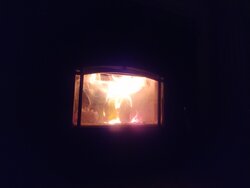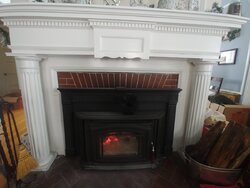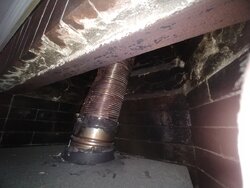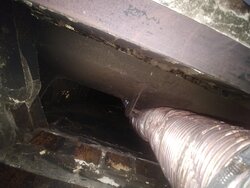Hi experts, I am new to using wood stoves and am hoping you can help me figure out what I'm doing wrong (or if my expectations are wrong). Long story short, my stove burns hot but the room it's in stays cool, and the stove isn't heating the rest of the level, let alone the rest of the house. I was hoping to rely less on gas to heat, but that is not proving to be the case.
I have an Enviro Boston 1700 insert, rated at 74000 BTU. It is connected to a newly installed 5.5 inch, 35-foot stainless liner (uninsulated) through an interior chimney. I am burning seasoned (2+ years split) locust and maple. The fire burns very hot (I don't have a thermometer to measure it but sitting within 2 feet of the stove it is so hot my eyes water!). It is in a 16'x24' room on the first floor of my house. It is an old home of masonry construction (clay block sandwiched between interior plaster and exterior stucco). Each of the 3 stories of my home is about 1700 sq ft. Floor plan is fairly open with wide doorways from room to room and a wide open staircase to the 2nd floor. Ceilings are 10 feet tall. I feed the stove with 3-5 logs every 3-5 hours and clean out ash every 3-4 days so I have a bed of ash and coals that ranges from 1 to 3 inches deep between cleanings. Once the fire is going, I close the air intake down to about 25% to get a nice slow flame with good secondary combustion.
My problem is that the room in which the stove is installed only stays between 65 and 68 degrees Fahrenheit when 15F to 35F outside, with the help of 2 steam radiators in the room. My thermostat to control the boiler is on the 2nd floor and is set between 64 and 67F depending on time of day. Boiler runs about 7 hours per day when below 30F outside. I run the fan on the Boston almost constantly, plus have a heat-powered fan on the top ledge of the stove. I have recently started using a box fan in a cold corner of the room to blow air toward the stove, which has helped raise the room temp about 1 degree on average vs without the fan. I am also using a small fan in the adjacent foyer to help move some of that warm air up the stairs.
I feel like I should be roasting in this room, and that the heat should carry throughout at least the first and possibly second floors of my home. What am I doing wrong? I've been in other wood-heated homes where you'd sweat in a t-shirt, yet my setup is producing lots of light bit little heat.
Am I expecting too much from the BTUs for my square footage? Any ideas to help keep the house more toasty with wood and with less reliance on gas?

I have an Enviro Boston 1700 insert, rated at 74000 BTU. It is connected to a newly installed 5.5 inch, 35-foot stainless liner (uninsulated) through an interior chimney. I am burning seasoned (2+ years split) locust and maple. The fire burns very hot (I don't have a thermometer to measure it but sitting within 2 feet of the stove it is so hot my eyes water!). It is in a 16'x24' room on the first floor of my house. It is an old home of masonry construction (clay block sandwiched between interior plaster and exterior stucco). Each of the 3 stories of my home is about 1700 sq ft. Floor plan is fairly open with wide doorways from room to room and a wide open staircase to the 2nd floor. Ceilings are 10 feet tall. I feed the stove with 3-5 logs every 3-5 hours and clean out ash every 3-4 days so I have a bed of ash and coals that ranges from 1 to 3 inches deep between cleanings. Once the fire is going, I close the air intake down to about 25% to get a nice slow flame with good secondary combustion.
My problem is that the room in which the stove is installed only stays between 65 and 68 degrees Fahrenheit when 15F to 35F outside, with the help of 2 steam radiators in the room. My thermostat to control the boiler is on the 2nd floor and is set between 64 and 67F depending on time of day. Boiler runs about 7 hours per day when below 30F outside. I run the fan on the Boston almost constantly, plus have a heat-powered fan on the top ledge of the stove. I have recently started using a box fan in a cold corner of the room to blow air toward the stove, which has helped raise the room temp about 1 degree on average vs without the fan. I am also using a small fan in the adjacent foyer to help move some of that warm air up the stairs.
I feel like I should be roasting in this room, and that the heat should carry throughout at least the first and possibly second floors of my home. What am I doing wrong? I've been in other wood-heated homes where you'd sweat in a t-shirt, yet my setup is producing lots of light bit little heat.
Am I expecting too much from the BTUs for my square footage? Any ideas to help keep the house more toasty with wood and with less reliance on gas?







